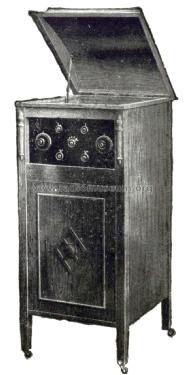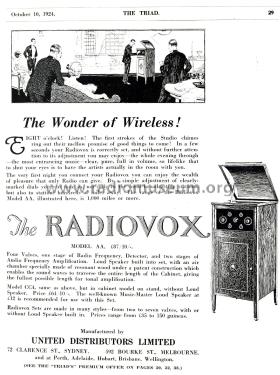Radiovox AA
United Distributors Ltd. (Udisco); Sydney, NSW
- País
- Australia
- Fabricante / Marca
- United Distributors Ltd. (Udisco); Sydney, NSW
- Año
- 1924
- Categoría
- Radio - o Sintonizador pasado WW2
- Radiomuseum.org ID
- 330737
- Numero de valvulas
- 4
- Válvulas
- Principio principal
- RFS (Radio Frecuencia Sintonizada) en general
- Gama de ondas
- OM (onda media) solamente
- Tensión de funcionamiento
- Pilas + jack (etc.) para alimentación externa.
- Altavoz
- -Altavoz incorporado, sistema desconocido.
- Material
- Madera
- de Radiomuseum.org
- Modelo: Radiovox AA - United Distributors Ltd.
- Forma
- Consola baja, patas más cortas del 50%.
- Anotaciones
-
MODEL AA, Four Valves, one stage of Radio Frequency, Detector, and two stages of Amplification. Loudspeaker built into set, with an air chamber specially made of resonant wood under a patent construction which enables sound waves to traverse the entire length of the Cabinet, giving the fullest possible length for tonal amplification.
The Triad, October 10, 1924, Page 29.
- Precio durante el primer año
- 87.50 AUS £
- Mencionado en
- The Triad, October 10, 1924, Page 29.
- Autor
- Modelo creado por Gary Cowans. Ver en "Modificar Ficha" los participantes posteriores.
- Otros modelos
-
Donde encontrará 41 modelos, 37 con imágenes y 1 con esquemas.
Ir al listado general de United Distributors Ltd. (Udisco); Sydney, NSW
Contribuciones en el Foro acerca de este modelo: United Distributors: Radiovox AA
Hilos: 1 | Mensajes: 1
No. 14288/23: APPLICANT (ACTUAL INVENTOR), L. D. RUDOLPH, SYDNEY, N.S.W.
For improvements in cabinets for wireless receiving sets such as are employed for the reception of broadcast programmes. Fig. 2 is a perspective view of the improved cabinet, one object of which is the arrangement whereby the amplifying apparatus occupies a minimum space, whilst a maximum sound amplification is produced.
Another object is to provide a cabinet wherein the closing of the hinged lid puts the apparatus out of service for reception by operating a switch to break the filament current supply to the thermionic valves. The cabinet (5) of veneer wood is constructed with an open end (6) and a hinged cover (8). The body of the cabinet is divided by a shelf (9) into two compartments (10 and 11), the lower having a hinged swinging door (12).
The upper compartment is provided with a front panel of ebonite, upon which is mounted the control handles if the wireless apparatus. When the cabinet is not in use the control panel may be concealed by the hinged flap (18).
The lower compartment is designed to accommodate the low-tension battery (21) and the high-tension battery (22) of the amplifier and may be enclosed by means of the door (12). In the same compartment a sound amplifier (24) is mounted and associated with a wooden horn (25), which extends upwards to be flush with the top of the cabinet: A detachable cover (27) provided with fine wire gauze is fitted to the upper part of the cabinet, whilst the lid is hinged with a toothed link by means of which the volume of sound from the reproducer may be varied by adjusting the lid opening to various angles. Sockets are provided for connecting the aerial and earth wires to the apparatus.
Radio in Australia & NZ, February 4, 1925, page 732 & 733
Gary Cowans, 08.Jul.21

